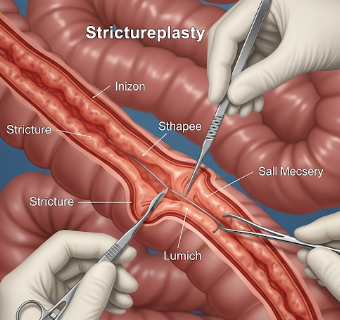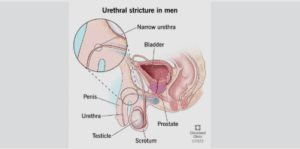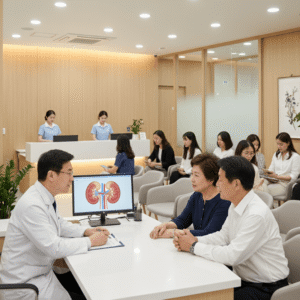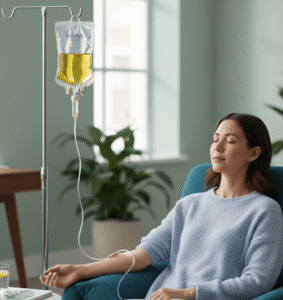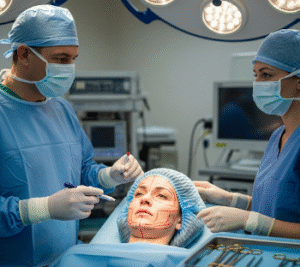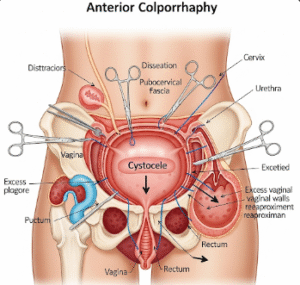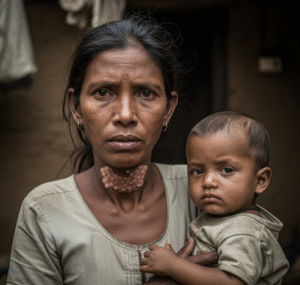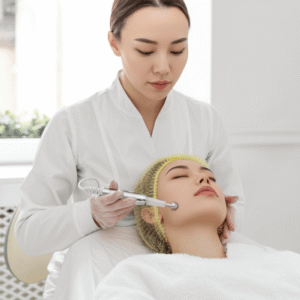Overview
Strictureplasty is a surgical procedure designed to treat narrowed sections of the intestines, commonly caused by Crohn’s disease or other chronic inflammatory bowel conditions. Instead of removing the affected intestinal segment, strictureplasty widens the narrowed area while preserving as much healthy intestine as possible.
This procedure is particularly important for patients who have recurrent strictures, as it prevents short bowel syndrome that can occur with repeated intestinal resections. In Korea, strictureplasty is offered in advanced gastroenterology and colorectal surgery centers, known for combining minimally invasive techniques with expert post-operative care.
What is Strictureplasty?
Strictureplasty is a surgical technique that enlarges narrowed portions of the small or large intestine without removing them.
There are several types of strictureplasty:
- ✦ Heineke-Mikulicz strictureplasty – for short strictures (<7 cm).
- ➤ Finney strictureplasty – for moderate-length strictures (7–15 cm).
- ✦ Michelassi strictureplasty – for long or multiple strictures (>15 cm).
By preserving intestinal length, strictureplasty maintains nutrient absorption and reduces the risk of complications from multiple resections.
What are the Benefits?
Strictureplasty provides several advantages for patients with intestinal strictures:
✅ Preserves intestinal length, reducing risk of short bowel syndrome.
➤ Relieves obstruction symptoms – abdominal pain, bloating, nausea, and vomiting.
✦ Reduces recurrence of strictures compared to untreated segments.
➤ Shorter hospital stay and faster recovery than traditional resection.
✅ Minimally invasive options available for eligible patients.
✦ Improved quality of life – patients can resume normal diet and daily activities sooner.
Procedure Details
1) How should I prepare for Strictureplasty?
Preparation steps include:
- ✦ Pre-operative imaging (CT, MRI, or contrast studies) to locate strictures accurately.
- ➤ Bowel preparation – cleaning the intestines before surgery.
- ✦ Blood tests and medical evaluation to ensure fitness for anesthesia.
- ➤ Medication adjustments – stopping blood thinners or anti-inflammatory drugs.
- ✦ Discussion with your surgeon about procedure type, risks, and expected outcomes.
- ➤ Fasting 6–8 hours before surgery.
2) What happens during the procedure Strictureplasty?
Strictureplasty is usually performed under general anesthesia. The steps are:
➤ Step 1: A small abdominal incision is made (or laparoscopic ports are inserted for minimally invasive surgery).
✦ Step 2: The affected segment of intestine is identified and isolated.
➤ Step 3: The stricture is opened longitudinally, and the intestinal walls are rearranged or folded to widen the lumen.
✦ Step 4: Sutures are used to secure the opened segment and restore normal passage.
➤ Step 5: The incision is closed, and drains may be placed temporarily if necessary.
The procedure is carefully tailored to the length and location of the stricture.
3) What happens after a Strictureplasty?
Post-operative care includes:
- ✦ Hospital monitoring for 2–7 days, depending on the extent of surgery.
- ➤ Pain management and gradual reintroduction of diet.
- ✦ Observation for complications like leakage, bleeding, or infection.
- ➤ Early mobilization to prevent blood clots and promote bowel function.
- ✦ Follow-up imaging may be conducted to ensure intestinal patency.
- ➤ Long-term monitoring for Crohn’s disease activity to prevent new strictures.
Patients can usually resume normal activities within 4–6 weeks, depending on recovery and complexity of the procedure.
Risks / Benefits
Potential Risks:
- ✦ Infection at the surgical site or within the abdomen.
- ➤ Leakage from the sutured intestinal segment.
- ✦ Bleeding or blood clots.
- ➤ Bowel obstruction if swelling or scar tissue develops.
- ✦ Recurrence of strictures in other intestinal segments.
Benefits:
- ✅ Preserves intestinal length and function.
- ✅ Relieves obstruction symptoms effectively.
- ✅ Shorter recovery compared to intestinal resection.
- ✅ Can be repeated if new strictures occur.
Recovery and Outlook
Recovery is generally smooth with proper care:
- ➤ Hospital stay: 2–7 days depending on procedure complexity.
- ✦ Return to daily activities: 4–6 weeks.
- ➤ Diet: Start with liquids, progress to soft foods, then regular diet.
- ✦ Long-term outlook: Good, especially with proper Crohn’s disease management and medication adherence.
- ➤ Recurrence monitoring: Periodic imaging and gastroenterologist follow-up.
Strictureplasty helps patients maintain intestinal length, nutritional status, and quality of life.
When To Call the Doctor
Patients should contact their healthcare provider if they notice:
⚠ Severe abdominal pain or distension.
⚠ Fever, chills, or signs of infection.
⚠ Persistent vomiting or inability to tolerate food.
⚠ Blood in stool or unusual bowel changes.
⚠ Leakage from incision or surgical drains.
Best Korea Option / Process
Korea offers world-class strictureplasty care with advantages such as:
- ✦ Expert colorectal surgeons trained in minimally invasive and open techniques.
- ➤ Advanced imaging for accurate stricture mapping.
- ✦ Multidisciplinary teams including gastroenterologists, nutritionists, and rehabilitation specialists.
- ➤ Affordable packages compared to Western countries.
- ✦ Post-operative monitoring and follow-up care to prevent complications.
- ➤ Hospitals equipped with robotic-assisted laparoscopic systems for precision surgery.
This makes Korea a leading destination for strictureplasty, combining advanced care, safety, and quick recovery.
Highlights of Strictureplasty in Korea
- ✅ Preserves intestinal length and function in Crohn’s disease or other strictures.
- ➤ Relieves symptoms of bowel obstruction effectively.
- ✦ Minimally invasive laparoscopic options for faster recovery.
- ➤ Performed by top Korean colorectal specialists.
- ✅ Comprehensive post-operative care with long-term disease monitoring.

